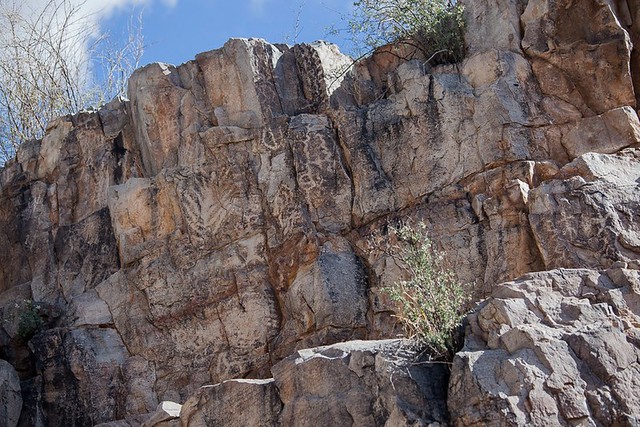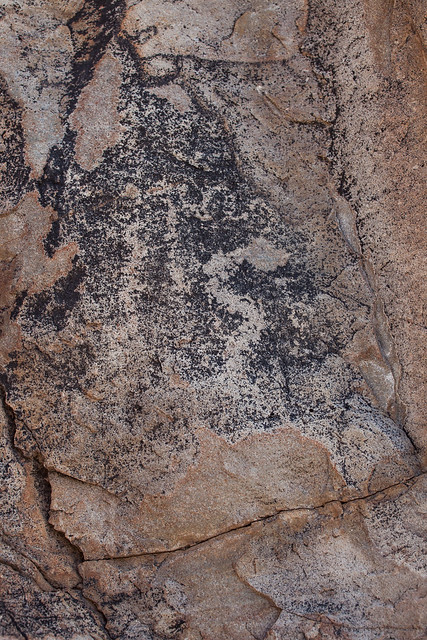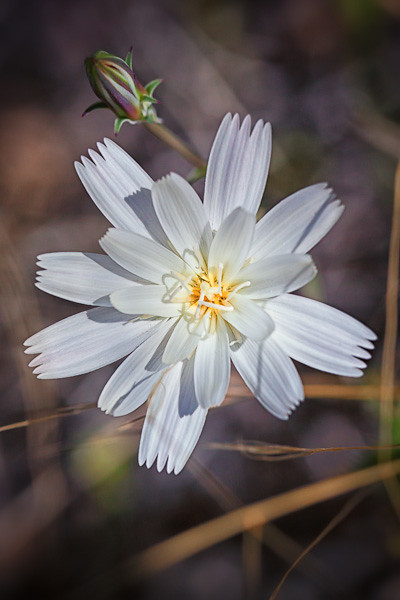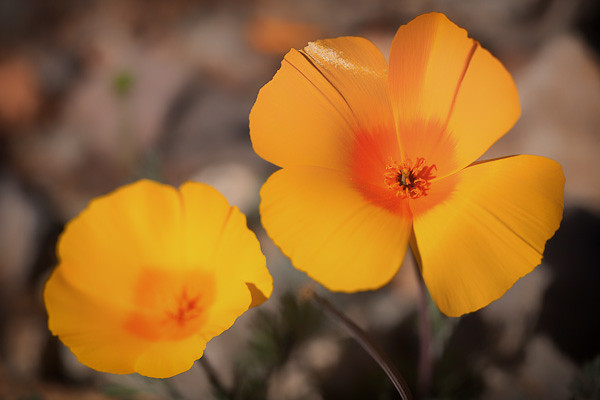“Men come and go, cities rise and fall, whole civilizations appear and disappear-the earth remains, slightly modified. The earth remains, and the heartbreaking beauty where there are no hearts to break….I sometimes choose to think, no doubt perversely, that man is a dream, thought an illusion, and only rock is real. Rock and sun.” ~ Edward Abbey, Desert Solitaire: A Season in the Wilderness
Deep in a canyon in the middle of the Sonoran Desert, the cliff walls transition from red and gray striated rock to a giant wall of petroglyphs, figures pecked and carved into an ancient layer of the black desert varnish which covers many of the rocky surfaces.
Scientists estimate that many of the petroglyphs were carved from about 300 A.D. until 1300 A.D..
The Hohokam may have pecked these petroglyphs while on hunting and gathering expeditions, or during religious or other ceremonies. Perhaps they are solstice markers, tribe symbols, decorative art, or even an ancient form of graffiti.
Studying these mysterious symbols, I began to wonder at the message as it was intended, nearly a thousand years ago. A message whose meaning has disappeared just as the Ancient Ones disappeared from these lands almost overnight, back in the 1300s. Some of the markings do align with the solar calendar – one spiral in this canyon is precisely half-illuminated by a slit of light as it shines through a split rock, This happens only twice a year – at the vernal and autumnal equinoxes.
I viewed the spiral on the vernal equinox and watched as sunlight illuminated exactly half the spiral. On the March day when it is half light/half dark. Twelve hours of day and twelve hours of night. Halving the spiral into equal parts of light and dark.
What messages might you take from symbols as they appear in your daily life?
After researching these petroglyphs, I realized:
- things are not always as they seem
- that sometime, in the mystery, lies the unexpected answer
- that I see/study symbols and may incorporate meaning as I understand it into my life
For example, the snake petroglyph is geometric and prominent amidst the other carvings. There is no way to know what the snake symbol meant to the ancient Hohokam. Yet I can make my own interpretation of the snake and its message, as it pertains to my life, today.
Snakes become dormant in colder months, expending little energy. They are summoned by the lengthening days, by the sun’s longer appearance each day, and they move towards warmth and the life giving powers of the sun. Snakes move in rhythm with the natural cycle, the natural forces of nature. I, too, am drawn to the longer days and tend to slow down as the days shorten. Or I seek places of sunshine, places and spaces that provide warmth.
The snake is of the earth. It crawls upon the earth, burrows into the earth for shelter, warmth, protection. I feel grounded when I stand upon the earth, and focus my energy downward, anchoring deep within the earth.
Snake is ruled by instinct for survival. I, too, live by instincts – some of which I follow, often finding my way; some which I ignore, sometimes to my detriment.
Snake is powerful, often feared, and sometimes is killed or hurt unnecessarily by people who are frightened and do not understand the ways of the snake. How does this relate to me? When I follow my passions, and insticts, take risks, do the unexpected, how do others respond to me? How does this affect my forward movement?
What might snake’s message mean to you?













